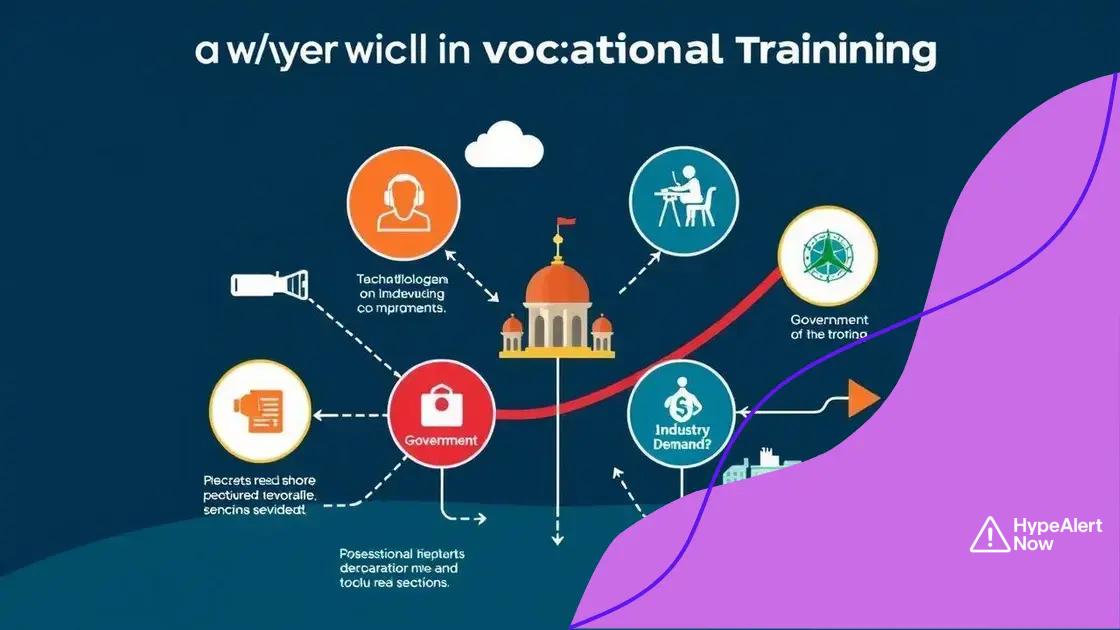Growth in vocational training and workforce skills: unlocking potential

Growth in vocational training and workforce skills focuses on enhancing digital and soft skills, emphasizing hands-on experiences, and adapting educational programs to meet the evolving demands of the job market.
Growth in vocational training and workforce skills is essential for adapting to an ever-changing job market. But have you ever wondered how this affects your future career opportunities?
The evolution of vocational training
The evolution of vocational training has been remarkable over the years. It has transformed from traditional practices to modern approaches that meet the needs of today’s workforce. Understanding this change is essential to grasp the value of vocational education.
Historical Overview
Vocational training dates back to ancient times, with apprenticeships forming the backbone of skill development. These apprenticeships allowed young individuals to learn from skilled artisans. As societies advanced, the demand for skilled workers led to the establishment of more formal training programs.
Modern Approaches
Today, vocational training incorporates technology and innovative teaching methods. This evolution focuses on practical skills that align with industry standards. Here are some modern features:
- Use of online platforms for flexible learning.
- Integration of real-world projects into the curriculum.
- Collaboration with employers to tailor programs to specific job markets.
The need for skilled labor continues to grow. As technology evolves, so do the skills required. This means that vocational training must adapt quickly to ensure students are prepared for the workforce.
Impact on Employment
With the rise in vocational training programs, many individuals find better job opportunities. Skills developed through these programs are in high demand, benefiting both the workforce and the economy. The focus is shifting from traditional four-year degrees to skill-based training, making education accessible and relevant.
In summary, the evolution of vocational training reflects the changing landscape of the job market. By emphasizing practical skills and adapting to new technologies, vocational education helps individuals thrive in their careers. It’s an essential component in today’s education system, paving the way for a more skilled workforce.
Importance of workforce skills in today’s job market
The importance of workforce skills in today’s job market cannot be overstated. As industries evolve, the demand for skilled workers increases. Companies are actively seeking employees who possess the right skills to meet their needs.
Key Skills Employers Look For
In the current landscape, several skills stand out as essential. Understanding what employers value can help job seekers tailor their training and improve their employability. Some key skills include:
- Technical proficiency in relevant software and tools.
- Strong communication and teamwork abilities.
- Problem-solving skills that enhance decision-making.
- Adaptability to new technologies and processes.
Employers recognize that a well-rounded skill set is beneficial to their organizations. Workers who can adapt and learn quickly tend to thrive in dynamic workplaces.
The Changing Nature of Work
As technology continues to advance, the nature of work is evolving. Many tasks are now automated, necessitating a focus on skills that technology cannot replicate. Skills like creativity and emotional intelligence are becoming increasingly valuable. This shift means individuals must adapt by acquiring both hard and soft skills to remain competitive.
Furthermore, training programs have started emphasizing the development of these critical skills. Networking and interpersonal skills are also more crucial than ever, as professionals often collaborate across various disciplines. This collaboration encourages the sharing of knowledge and ideas, leading to innovation.
In summary, the importance of workforce skills in today’s job market is profound. Skills that blend technical expertise with interpersonal abilities are essential for success in a fast-changing environment. By focusing on developing a diverse skill set, workers can enhance their career prospects and contribute meaningfully to their organizations.
Key factors driving growth in vocational training

Several key factors driving growth in vocational training highlight its increasing importance in today’s workforce. With rapid technological advancements and evolving job requirements, these factors are critical for adapting training programs.
Industry Demand
The demand for skilled labor is growing across various industries. Companies are continually seeking workers who possess specific competencies. This trend encourages vocational training programs to align their curricula with industry needs.
Technological Advancements
Technology plays a significant role in shaping vocational training. Online learning platforms and digital tools allow for more accessible and flexible training options. This shift not only attracts more students but also enhances learning experiences.
- Virtual simulations for practical experience.
- Access to a broad range of resources online.
- Customized learning paths to suit individual needs.
Moreover, technology enables trainers to implement innovative teaching methods. This adaptability keeps vocational training relevant in a fast-paced job market.
Government Support
Government initiatives also propel the growth of vocational training. Policies promoting workforce development often include funding for training programs. By investing in vocational education, governments aim to boost employment rates and economic growth.
As a result, many vocational training institutions receive grants to enhance their services. This support allows them to expand their offerings to meet community needs. Access to affordable training can help individuals gain skills that lead to stable employment.
Finally, shifting societal perceptions about vocational education are contributing to its growth. More people recognize the value of skilled trades and the opportunities they offer. This cultural shift is encouraging young people to consider vocational paths alongside traditional degrees.
Innovative approaches to vocational education
Innovative approaches to vocational education are reshaping the way skills are taught and learned. As industries evolve, so does the method of delivering educational content. These new approaches seek to enhance student engagement and ensure graduates are job-ready.
Blended Learning Models
Blended learning combines traditional face-to-face instruction with online components. This flexibility allows students to learn at their own pace while also benefiting from direct interactions with instructors. Here are some advantages:
- Access to online resources anytime.
- Ability to revisit complex topics.
- Enhanced collaboration through online discussion forums.
With this model, students can engage deeply with the material. This method not only caters to different learning styles but also prepares students for a future where online competency is crucial.
Hands-On Learning Experiences
Another innovative approach is emphasizing hands-on, real-world experiences. Crafting partnerships with local businesses allows students to gain practical experience. This method leads to:
- Internships that provide on-the-job training.
- Projects that address real industry challenges.
- Networking opportunities with potential employers.
Hands-on experiences are invaluable because they bridge the gap between theory and practice. Students become more confident and better equipped for their future careers.
Moreover, technology is playing a significant role in transforming vocational education. Tools like virtual reality (VR) and augmented reality (AR) offer immersive learning experiences. For instance, VR can simulate complex environments for students to practice their skills without real-world risks. This adaptability keeps education relevant in a rapidly changing job market.
The growing focus on soft skills is also notable in vocational education programs. Skills like communication, teamwork, and problem-solving are integrated into the curriculum. This holistic approach ensures that students are well-rounded and ready to meet employer expectations.
Future trends in workplace skills development
Future trends in workplace skills development are crucial to understanding how the job market is changing. As technology and workplaces evolve, the skills needed by employees are also shifting. Staying ahead of these trends is essential for both workers and employers.
The Rise of Digital Skills
One major trend is the increasing emphasis on digital skills. Many jobs now require proficiency in software and technology. As automation becomes more common, workers need to adapt to new tools. Companies are actively looking for candidates who can:
- Navigate complex software applications.
- Analyze data to make informed decisions.
- Use social media and digital marketing effectively.
This demand means educational programs are updating their curricula to include these skills. Learning digital skills is no longer optional; it is a necessary part of workforce training.
Soft Skills Development
Alongside digital skills, there is a growing recognition of the value of soft skills. Employers are looking for individuals who can communicate effectively and work well in teams. Skills like emotional intelligence and conflict resolution are vital in today’s collaborative work environments. Workers who can:
- Build strong interpersonal relationships.
- Adapt to changing situations.
- Lead and motivate others.
are often more successful in their roles. Therefore, many training programs are incorporating soft skills development into their courses. This focus creates well-rounded individuals who can thrive in diverse settings.
Moreover, lifelong learning is another emerging trend. As industries change rapidly, education does not end with formal schooling. Workers are encouraged to seek continuous improvement through online courses, workshops, and professional development opportunities. This commitment to learning helps individuals stay relevant in a competitive job market.
Finally, collaboration between educational institutions and businesses is becoming more common. By working together, they can ensure that training programs align with industry needs. This partnership helps create a workforce that is not only well-trained but also ready to meet the challenges of the future.
FAQ – Frequently Asked Questions about Future Trends in Workplace Skills Development
What digital skills are most important in today’s job market?
Skills like data analysis, software proficiency, and online communication are crucial as companies seek tech-savvy employees.
Why are soft skills essential in the workplace?
Soft skills, such as teamwork and communication, enhance collaboration and improve overall workplace harmony, making them invaluable.
How can I continue learning after completing a vocational program?
Look for online courses, workshops, and professional development opportunities to keep your skills updated and relevant.
What role do industry partnerships play in vocational education?
Industry partnerships help align training programs with real-world job needs, ensuring that graduates are job-ready and employers find competent workers.
